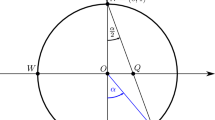Abstract
This paper describes how surface shape, and in particular facial shape, can be modeled using a statistical model that captures variations in surface normal direction. To construct this model we make use of the azimuthal equidistant projection to map surface normals from the unit sphere to points on a local tangent plane. The variations in surface normal direction are captured using the covariance matrix for the projected point positions. This allows us to model variations in surface shape using a standard point distribution model. We show how this model can be trained using surface normal data acquired from range images. We fit the model to intensity data using constraints on the surface normal direction provided by Lambert’s law. We demonstrate the utility of the method on the recovery of 3D surface shape from 2D images.
Preview
Unable to display preview. Download preview PDF.
Similar content being viewed by others
References
Zhang, R., Tsai, P.S., Cryer, J.E., Shah, M.: Shape-from-shading: a survey. IEEE Trans. PAMI 21, 690–706 (1999)
Gregory, R.L.: Knowledge in perception and illusion. Phil. Trans. R. Soc. Lond. B 352, 1121–1128 (1997)
Georghiades, A., Belhumeur, P., Kriegman, D.: From few to many: Illumination cone models for face recognition under variable lighting and pose. IEEE Trans. PAMI 23, 643–660 (2001)
Atick, J.J., Griffin, P.A., Redlich, A.N.: Statistical approach to SFS: Reconstruction of 3D face surfaces from single 2D images. Neural Comp. 8, 1321–1340 (1996)
Zhao, W.Y., Chellappa, R.: Illumination-insensitive face recognition using symmetric SFS. In: Proc. CVPR (2000)
Samaras, D., Metaxas, D.: Illumination constraints in deformable models for shape and light direction estimation. IEEE Trans. PAMI 25, 247–264 (2003)
Castelán, M., Hancock, E.R.: Acquiring height maps of faces from a single image. In: Proc. 3DPVT, pp. 183–190 (2004)
Prados, E., Faugeras, O.: A rigorous and realistic shape from shading method and some of its applications. Technical Report RR-5133, INRIA (2004)
Heap, T., Hogg, D.: Extending the point distribution model using polar coordinates. Image and Vision Computing 14, 589–599 (1996)
Snyder, J.P.: Map Projections–A Working Manual, U.S.G.S. Professional Paper 1395. United States Government Printing Office, Washington D.C (1987)
Cootes, T.F., Taylor, C., Cooper, D., Graham, J.: Training models of shape from sets of examples. In: Proc. BMVC, pp. 9–18 (1992)
Worthington, P.L., Hancock, E.R.: New constraints on data-closeness and needle map consistency for shape-from-shading. IEEE Trans. PAMI 21, 1250–1267 (1999)
Worthington, P.L., Hancock, E.R.: Surface topography using shape-from-shading. Pattern Recognition 34, 823–840 (2001)
Sirovich, L.: Turbulence and the dynamics of coherent structures. Quart. Applied Mathematics XLV, 561–590 (1987)
Frankot, R.T., Chellappa, R.: A method for enforcing integrability in shape from shading algorithms. IEEE Trans. PAMI 10, 439–451 (1988)
Turk, M., Pentland, A.: Face recognition using eigenfaces. In: IEEE Conf. CVPR, pp. 586–591 (1991)
Cootes, T.F., Edwards, G.J., Taylor, C.J.: Active appearance models. In: Burkhardt, H., Neumann, B. (eds.) ECCV 1998. LNCS, vol. 1407, pp. 484–498. Springer, Heidelberg (1998)
Author information
Authors and Affiliations
Editor information
Editors and Affiliations
Rights and permissions
Copyright information
© 2005 Springer-Verlag Berlin Heidelberg
About this paper
Cite this paper
Smith, W.A.P., Hancock, E.R. (2005). Modelling Surface Normal Distribution Using the Azimuthal Equidistant Projection. In: Martin, R., Bez, H., Sabin, M. (eds) Mathematics of Surfaces XI. Lecture Notes in Computer Science, vol 3604. Springer, Berlin, Heidelberg. https://doi.org/10.1007/11537908_23
Download citation
DOI: https://doi.org/10.1007/11537908_23
Publisher Name: Springer, Berlin, Heidelberg
Print ISBN: 978-3-540-28225-9
Online ISBN: 978-3-540-31835-4
eBook Packages: Computer ScienceComputer Science (R0)




